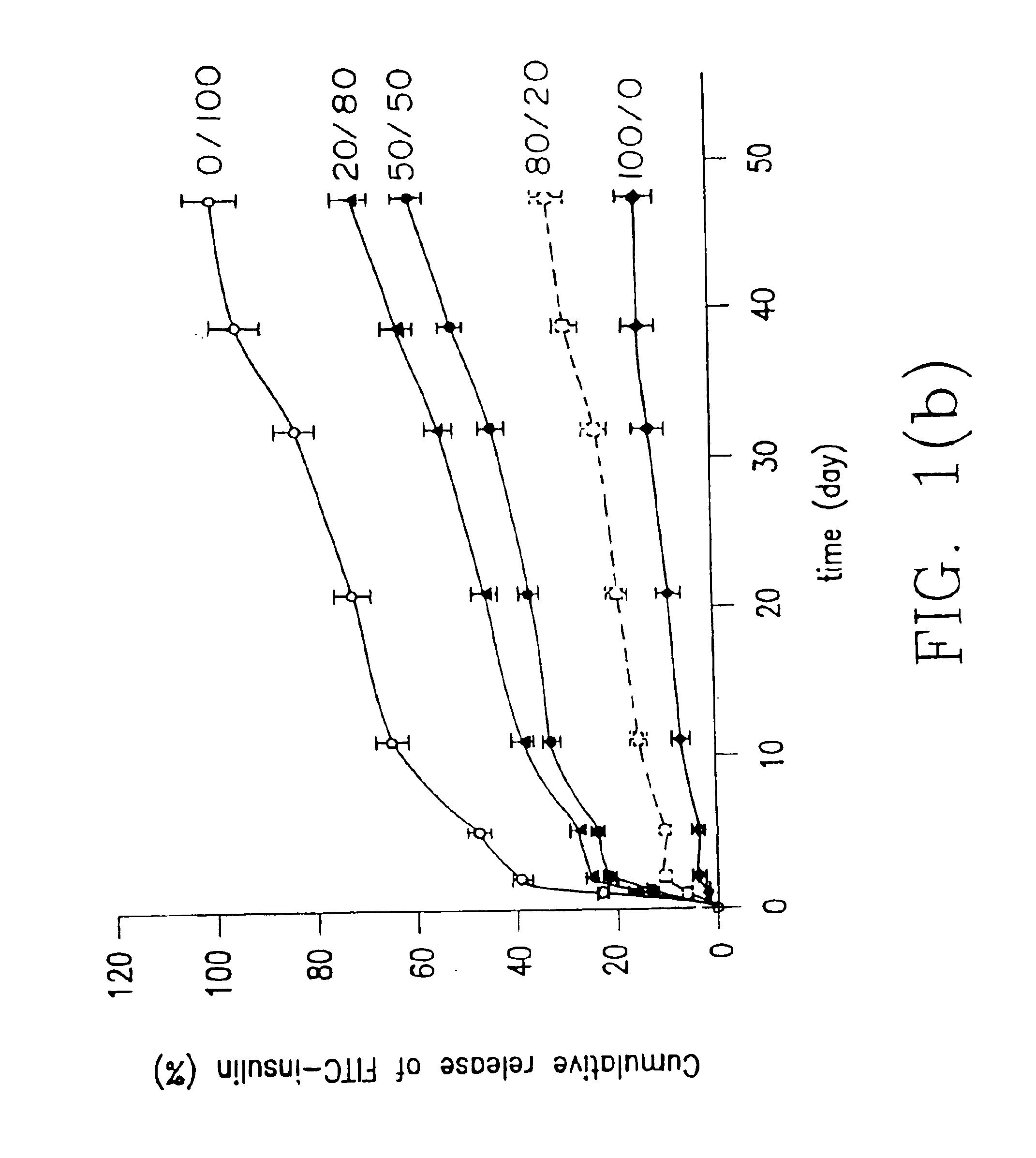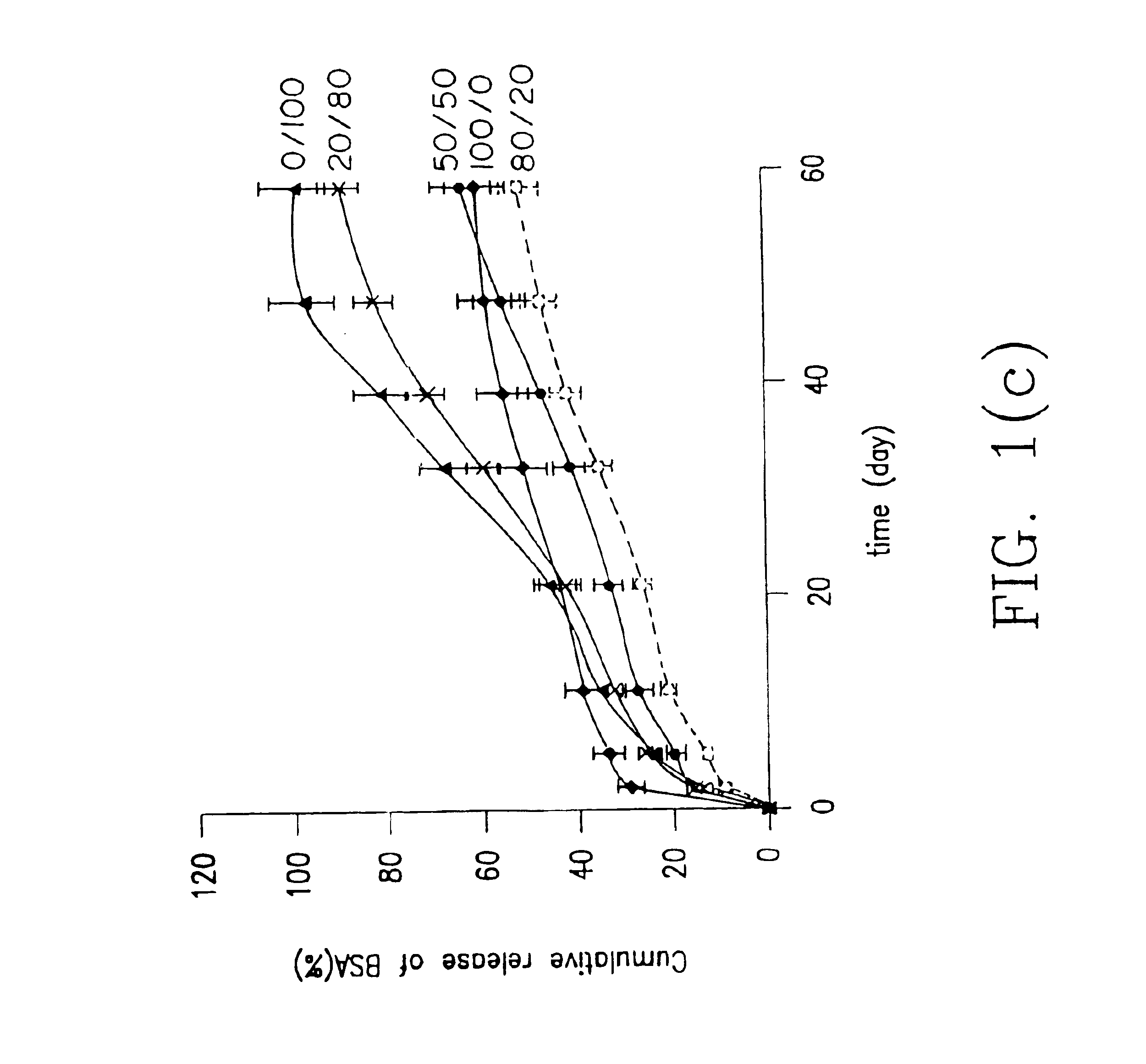Hydrogel entrapping therapeutic agent and stent with coating comprising this
a technology of hydrogel and therapeutic agent, which is applied in the direction of prosthesis, impression caps, bandages, etc., can solve the problems of poor integration between hydrophilic and hydrophobic components, lack of hydrogel, and method of physical blending
- Summary
- Abstract
- Description
- Claims
- Application Information
AI Technical Summary
Benefits of technology
Problems solved by technology
Method used
Image
Examples
example i
[0060]Poly-D,L-lactic acid (PDLLA), 5 gms, of weight average molecular weight of 800 was dissolved in tetrahydrofuran (concentration of 8% (w / v)) in a round-bottomed three-neck flask under nitrogen purge and the solution was cooled to 0° C. in an ice bath. Then 1.4 gms of 1,3-dicyclohexylcarbodiimide (DCC) and 0.9 gms 1-hydroxybenzotriazole (HOBT) were added (the mole ratio of DCC to PDLLA was 1:1 and the mole ratio of HOBT to PDLLA was 1:1), and reaction was conducted for 0.5 hours with continuous stirring. Then the mixture was allowed to reach room temperature whereupon 0.45 ml of 2-aminoethanol (mole ratio of 2-aminoethanol to PDLLA of 1.1:1) was added dropwise to the flask and stirring was then continued for 0.5 hours. The precipitated byproduct, cyclohexylurea salt, was filtered out. The diol product was obtained by pouring the filtrate into a large excess of dry hexane. It was further purified by dissolution and reprecipitation several times using tetrahydrofuran and hexane, r...
example ii
[0064]Poly-D,L-lactic acid diacrylate to constitute the macromer (A) was obtained the same as in Example I.
[0065]Allyl isocyanate derivatized dextran was prepared as follows:
[0066]Dextran, 5 gms, having a weight average molecular weight of 43,000, was reacted with allyl isocyanate in the presence of dibutyltin dilaurate catalyst in a series of runs. In each of the runs, dry dextran was dissolved in anhydrous DMSO in a three-neck round bottom flask under a continuous nitrogen flow environment at room temperature. Then dibutyltin dilaurate (DBTDL) catalyst was injected into the solution at room temperature and then allyl isocyanate was added dropwise. In each case, the reaction mixture was stirred at a predetermined temperature for a predetermined time. Samples at different reaction times were withdrawn directly from the reaction flask with pipets. The resulting polymer samples were precipitated in cold excess isopropanol and were then further purified by dissolution and reprecipitati...
example iii
[0070]Indomethacin was used as a model drug to study release profiles of low molecular weight drugs from hydrogel prepared from hydrogel forming system herein. Indomethacin was particularly selected because it has potent gastrointestinal side effects following oral administration so a release system is important for it.
[0071]In this example, indomethacin was entrapped in hydrogels according to the invention (combinations of macromer (A) and polymer (B) over a range of composition ratios of (A) and (B)) and in hydrogels with only macromer (A) or polymer (B) and release in pH 7.4 phosphate buffered solution was investigated.
[0072]In a series of runs denoted the system 1 series of runs, the macromer (A) was PDLLA diacrylate macromer obtained from PDLLA (poly-D,L-lactic acid) having a weight average molecular weight of 800 and the polymer (B) was dex-AI where the dextran starting material had a weight average molecular weight of 43,000 and the dex-AI had a degree of substitution of 5.03...
PUM
| Property | Measurement | Unit |
|---|---|---|
| Fraction | aaaaa | aaaaa |
| Percent by mass | aaaaa | aaaaa |
| Percent by mass | aaaaa | aaaaa |
Abstract
Description
Claims
Application Information
 Login to View More
Login to View More - R&D
- Intellectual Property
- Life Sciences
- Materials
- Tech Scout
- Unparalleled Data Quality
- Higher Quality Content
- 60% Fewer Hallucinations
Browse by: Latest US Patents, China's latest patents, Technical Efficacy Thesaurus, Application Domain, Technology Topic, Popular Technical Reports.
© 2025 PatSnap. All rights reserved.Legal|Privacy policy|Modern Slavery Act Transparency Statement|Sitemap|About US| Contact US: help@patsnap.com



